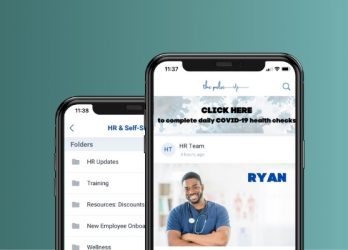Last updated on March 7, 2024 at 10:53 am
Employee onboarding is the biggest missed opportunity at most companies. That’s a pretty bold claim, isn’t it? But onboarding sets the stage for the rest of the employee experience, and we’re statistically awful at it. Here’s the sad truth about onboarding:
- 20% of turnover happens within a new hire’s first 45 days (SHRM).
- 35% of companies spend no money on onboarding (Enboarder).
- 60% of businesses don’t set any goals for new hires (HBR).
The good news is that we can turn things around. And the best way to improve employee onboarding is focusing on our internal communication. Let’s dive in.
What is Employee Onboarding?
Employee onboarding is the process of bringing a new hire into a company. This includes integrating them into the culture and teaching them the systems, processes, and rules of working at the company.
Typically, the employee onboarding experience is led at a high-level by the human resources team. They share the employee handbook, new hire paperwork, and getting the employee set up on the human resources information system (HRIS). HR may also have the employee complete necessary training and compliance courses, such as HIPPA for healthcare, sexual harassment, data security and privacy, etc.
But people managers also play a big part in the onboarding process. Managers are responsible for integrating their new hires into the micro-culture of their team and are responsible for training that employee on the specific knowledge, skills, and systems they will need to do their job.
 Why is Onboarding New Employees So Important?
Why is Onboarding New Employees So Important?
Onboarding employees sets the stage for the rest of their employment. And you don’t get a second chance at that first impression.
And unfortunately, only 12% of employees think their employer does a good job with onboarding.
To understand why employee onboarding is so important, we need to talk about the costs of poor onboarding and the benefits when it’s done well.
The Costs of Poor Employee Onboarding:
When we fail to onboard employees successfully, there are many negative impacts, including:
- Increased risk of new hire churn. Research by Brandon Hall Group has found that good onboarding improves retention by 82%.
- Increased absenteeism. When employees aren’t clear on expectations and ways of working, they are far more likely to check out.
- Hurts the bottom line. Gallup has found that bad onboarding leads to higher levels of disengagement, which costs companies roughly 18% of their salary. And over time, these employees poison the well and hurt team culture and morale of their coworkers.
The Benefits of Great Employee Onboarding:
On the flip side, when we get onboarding right, there is a huge, positive impact:
- Improved employee productivity. Good onboarding leads to a 70% increase in worker productivity (Brandon Hall Group).
- Boosts employee engagement. When employees feel welcomed, knowledgeable, and confident, they are far more likely to be engaged in their work. And not just in the short term, but over a long period of time.
- Leads to more satisfied employees. Great onboarding doesn’t just focus on processes, it also focuses on employee development and goal setting. Companies that include development in the onboarding process see employee satisfaction increase by 3.5x. This also has a positive impact on the customer experience over time.
What Shouldn’t You Do When Onboarding a New Employee?
Given the risks of messing up employee onboarding…what does bad onboarding look like?
Well, honestly, a lot can ruin the new hire experience. Even the most well-meaning companies and teams often get a lot wrong in the onboarding process. Here are a few big things you shouldn’t do when onboarding a new employee:
- Mislead employees in the job description or interview process. When an employee’s expectations don’t match the reality of the job, this automatically creates tension. An employee isn’t going to want to say if you promise one thing and deliver something completely different.
- Not communicate ahead of time. Don’t hire someone and then ghost them until their first day! That creates a lot of anxiety and doesn’t give them a chance to ask their questions.
- Wing it. Too many companies don’t have a predefined onboarding and training plan. Sorry to say, but your new hires will notice that you don’t have your act together. And that doesn’t inspire confidence.
- Throw in the kitchen sink. If you overwhelm your employees during onboarding by sharing too much too fast, nothing is going to stick. They are going to feel overwhelmed out of the gate. And one of the most important things you need to build in those first days and weeks is a sense of self-efficacy—which is whether someone believes they are capable.
What Are the Steps to Onboarding a New Employee?
Your onboarding process might look different depending on your business. But all onboarding plans have some common goals:
- Welcome your employees
- Integrate them into the culture and into their team
- Ramp them up so they can be productive as quickly as possible
- Align them to the company goals
- Ensure they are in compliance with certifications, industry laws, and company policies
Because the goals of a successful onboarding program are the same, there are a few steps that have to happen.
Employee Onboarding Checklist
The most important thing to remember is that the employee experience starts before an employee’s first day. Their experience during the hiring process and the time leading up to their first day is all part of that critical first impression. Keep that in mind and follow these steps:
1. Set clear expectations leading up to the employee’s first day.
Obviously, you need to share when they are supposed to start. But there is more you can communicate to set clear expectations for their first day, which is key to a successful onboarding program. This may include sharing their first day schedule, who they’ll be meeting with, and even introducing them to their new team (if they haven’t already met) via email.
Responsible Party: Recruiting
2. Give the employee the onboarding roadmap.
Share exactly what the onboarding program entails and what the end goals are with new hires. Too often, employees feel aimless and lost in their first days or weeks on a job. You want to avoid that by having a clear orientation, welcome, and training program, and sharing that plan with them.
Responsible Party: Human Resources
3. Complete paperwork quickly.
Paperwork is a necessary part of the onboarding process. Get this done promptly so the new hire can focus on other things. But also remember that onboarding does not stop with paperwork. A study found that 58% of companies have an onboarding program that focuses on process and paperwork (HCI). This ignores things like culture, values, development, team building, and other critical components of a successful onboarding.
Responsible Party: Human Resources
4. Introduce the new hire to their team.
If you have an effective interview process, hopefully your new hires have already met a good portion of their direct team. But it’s important for that team to be ready to welcome and invite a new hire on their first day.
We’ve probably all experienced a first day on the job where it feels like everyone was too busy to take time to talk to you. And then you end up feeling a bit like an outsider as you go through virtual training and onboarding.
Onboarding should not be a solitary activity! So make sure the team is prepped to spend a little time with your new hire during their first few days at the company.
Responsible Party: Human Resources + Manager
5. Provide them with access to the tools and systems they’ll need.
When a new employee joins your team, they may or may not be familiar with the technology you use. Getting them access early on will help them start to familiarize themselves with the technology and how your team uses it.
Responsible Party: Human Resources + Manager
6. Schedule introduction meetings.
A big part of improving feelings of belonging in the workplace is to prevent your employees from feeling like they’re on an island. When you’re new to a job, you don’t know what you don’t know. So, it’s important to schedule meetings with other teams that they will be working with. This helps them socially integrate, but it will also improve productivity once they’re getting down to work.
Responsible Party: Manager
7. Begin training your new hire on ways of working.
Even though a new employee might be familiar with the actual work they’ll be doing, that doesn’t mean they’re used to your team and company norms. Introduce your new team member on how you do things and welcome their insight into other ways of working.
We really like the “watch one, do one, teach one” method. Here’s how it works:
- Watch One: Employees start by shadowing their trainer on a task. They can ask questions, observe, and take notes.
- Do One: The new hire then attempts the task for themselves with their trainer present. This gives them a chance to walk through the motions themselves and give it a stab while still having someone there to ask questions and advice of.
- Teach One: The new knowledge is then solidified when the employee again attempts the task, this time training their trainer. They explain what they’re doing and why.
Responsible Party: Manager
8. Collect new hire feedback.
No employee onboarding program should be complete without a new hire experience survey. Despite our best efforts welcoming new teammates onboard, we might not always get everything right.
- Was anything confusing or overwhelming?
- How effective was the new hire’s manager?
- How effective was HR?
- Were there any areas for improvement?
Ask these questions and more so you can continuously improve your onboarding experience. And get this: just asking for feedback can improve the employee-employer relationship by 91%.
Responsible Party: Human Resources
Why is Internal Communication Important During Onboarding?
So, what does internal communication have to do with onboarding? In a word: everything.
Communication is a critical part of every step in the employee onboarding process. And bad communication is a source of a lot of onboarding woes.
- Information a new hire receives before their first day is communication.
- HR’s rundown of policies, rules, and paperwork is all a form of communication.
- How their team welcomes them and trains them is all communication.
- Whether or not a new hire is asked to share their thoughts is communication.
Every step of the way, clear, timely communication is key to the success of your program. And this communication is the verbal communication between colleagues as well as the written plans, training materials, and information you share.
We’d even say that onboarding cannot be successful without effective communication.
Even if you think you have great communication—and a great onboarding experience—make sure you look at all the types of workers in your organization.
- Are your remote employees feeling welcomed and included enough? Without being physically present in the office, do they feel more isolated than the average employee would?
- Are your deskless employees receiving an equally thoughtful experience? Do they even have access to the communication channels you typically use to share information with new hires (e.g. your employee intranet or company email)?
Make sure you evaluate the challenges for successfully onboarding all types of employees and adjust for their unique needs as needed.
How Can HR and Internal Comms Create a Great Onboarding Experience?
You might have noticed that for each step in our employee onboarding checklist, we shared who is mainly responsible for that step in the process. The truth is, onboarding is a team sport. You need recruiting, HR, managers, a new hire’s peers, and more to create a good onboarding experience.
But the most important partnership is between the HR and internal communication teams. Why? Because people managers aren’t necessarily onboarding and employee communication experts. Even though it’s part of their job, they might not have the proper training and experience to welcome new employees to their teams effectively.
That’s where internal comms and HR come in. You are the experts! You’re the ones who can drive the company onboarding strategy and create a more positive employee experience.
But most importantly, HR and internal comms need to support their people managers. Give them an onboarding roadmap, important FAQs, communication tips, and a strategy to effectively bring on a new direct report. This can go a long way to creating a more unified and positive onboarding experience.
Communication Channels For Employee Onboarding
Just as it takes a village to effectively welcome new employees to our companies, it also takes a variety of internal communications channels.
Because you want to make sure that all your new hires can access important company information, it’s important to have a variety of channels they can use:
- Mobile App: An app is a great way to reach remote and non-desk employees. Your app, like your intranet, can store important information about the company, values, goals, and even your onboarding roadmap.
- Employee Intranet: An intranet can be a great tool for those who have access to it. This is a great place to showcase culture and values stories as well as important information about the company that can help new hires find their footing.
- Email: Email is a good push channel to get important procedural and legal information to employees.
- SMS Texts: Texting is great for first day reminders and ensuring compliance and regulatory training/paperwork is completed on time.
Subscribe To The theEMPLOYEEapp Newsletter
Comments are closed.





